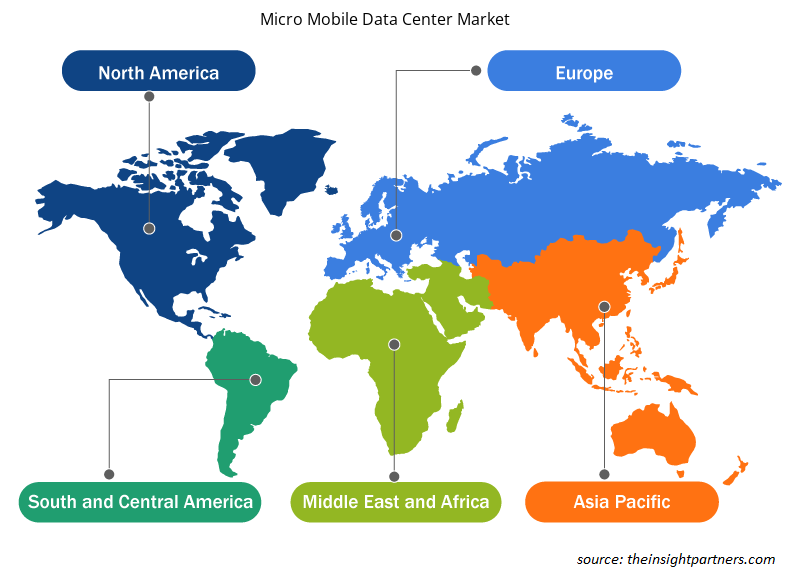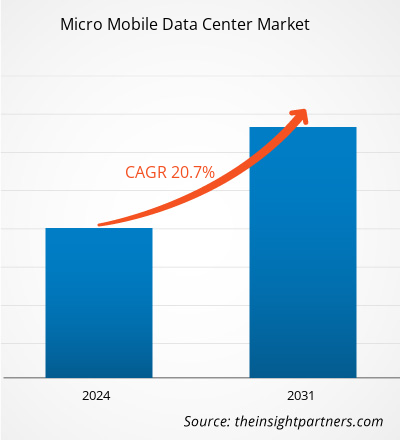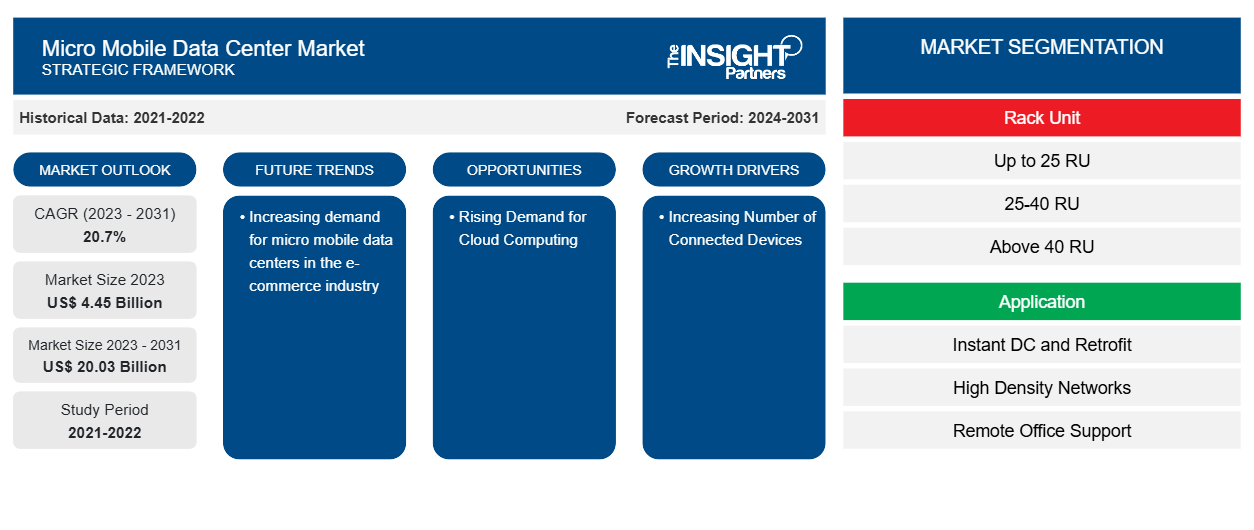Der Markt für mobile Mikrorechenzentren soll von 4,45 Milliarden US-Dollar im Jahr 2023 auf 20,03 Milliarden US-Dollar im Jahr 2031 anwachsen. Der Markt wird zwischen 2023 und 2031 voraussichtlich eine durchschnittliche jährliche Wachstumsrate (CAGR) von 20,7 % verzeichnen. Die steigende Nachfrage nach mobilen Mikrorechenzentren in der E-Commerce-Branche dürfte ein wichtiger Trend auf dem Markt bleiben.
Marktanalyse für Mikro-Mobil-Rechenzentren
Mikromobile Rechenzentren sind für die Bereitstellung von Edge-Computing-Funktionen von entscheidender Bedeutung. Sie fungieren als Knotenpunkte für eine Vielzahl von Anwendungen, darunter Content Delivery Networks (CDNs), Echtzeitanalysen und das Internet der Dinge (IoT). Darüber hinaus erfüllen Mikromobile Rechenzentren die Infrastrukturanforderungen von 5G-Telekommunikationsnetzen und stellen gleichzeitig IT-Dienste für Remote- und Zweigstellen bereit. Darüber hinaus erhöht die zunehmende Einführung cloudbasierter Lösungen und Dienste den Bedarf an Mikromobilen Rechenzentren weltweit und schafft so weitere Wachstumschancen für den Markt.
Marktübersicht für Mikro-Mobil-Rechenzentren
Ein Mikrorechenzentrum (MDC) ist ein kleines, in sich geschlossenes Rechenzentrum, das in der Nähe der Benutzer oder Geräte aufgestellt werden soll, die es unterstützt. Mikrorechenzentren sind tragbar und in verschiedenen Größen erhältlich, darunter ein halbes Rack, ein einzelnes Rack, mehrere Racks und sogar ein kleiner ISO-Versandcontainer (20 Fuß lang und 8 Fuß breit). Sie können je nach Bedarf im Innen- oder Außenbereich verwendet werden. Obwohl die meisten Mikrorechenzentren bodenstehend sind, können kleinere Versionen für mehr Flexibilität auch an der Wand montiert werden.
Passen Sie diesen Bericht Ihren Anforderungen an
Sie erhalten kostenlos individuelle Anpassungen an jedem Bericht, einschließlich Teilen dieses Berichts oder einer Analyse auf Länderebene, eines Excel-Datenpakets sowie tolle Angebote und Rabatte für Start-ups und Universitäten.
-
Holen Sie sich die wichtigsten Markttrends aus diesem Bericht.Dieses KOSTENLOSE Beispiel umfasst eine Datenanalyse von Markttrends bis hin zu Schätzungen und Prognosen.
Markttreiber und Chancen für Micro Mobile Data Center
Zunehmende Anzahl vernetzter Geräte
Laut dem Bericht von Telefonaktiebolaget LM Ericsson lag die Zahl der über Massive-IoT-Technologien verbundenen Geräte Ende 2022 bei rund 500 Millionen. Dieses Wachstum der Massive-IoT-Technologien ist auf die zusätzlichen Fähigkeiten der Netzwerke zurückzuführen, die es Massive IoT ermöglichen, durch Spektrum-Sharing mit 4G und 5G in Frequenzduplex-Bändern (FDD) zu koexistieren. Außerdem erreichte Breitband-IoT im Jahr 2022 1,3 Milliarden Verbindungen und trug dazu bei, den größten Anteil aller zellularen IoT-Geräte zu verbinden. Darüber hinaus steigert die zunehmende Einführung von 5G weltweit die Zahl der IoT-Geräte. Laut der Groupe Speciale Mobile Association (GSMA) lag die 5G-Durchdringung im Jahr 2022 weltweit bei 17 % und soll bis 2030 54 % erreichen. Nordamerika hat die höchste 5G-Durchdringung; Im Jahr 2022 lag sie bei 39 % und soll bis 2030 91 % erreichen. Ebenso verzeichneten die Regionen Asien-Pazifik (außer China) und Europa im Jahr 2022 eine 5G-Durchdringung von 4 % bzw. 11 %, die bis 2030 voraussichtlich 41 % bzw. 87 % erreichen wird. Dieser Anstieg der Anzahl verbundener Geräte wird eine große Menge an Daten erzeugen , die das Wachstum des Marktes weiter ankurbeln wird.Telefonaktiebolaget LM Ericsson, the number of devices connected through Massive IoT technologies reached approximately 500 million at the end of 2022. This growth of Massive IoT technologies is due to the added capabilities in the networks, which enables Massive IoT to coexist with 4G and 5G in frequency division duplex (FDD) bands via spectrum sharing. Also, in 2022, broadband IoT reached 1.3 billion connections and helped connect the largest share of all cellular IoT devices. In addition, the rising adoption of 5G worldwide is boosting the number of IoT devices. According to the Groupe Speciale Mobile Association (GSMA), in 2022, 5G penetration accounted for 17% across the world, which is expected to reach 54% by 2030. North America has the highest 5G penetration; it was recorded to be 39% in 2022 and is expected to reach 91% by 2030. Similarly, in 2022, Asia Pacific (except China) and Europe recorded 4% and 11% of 5G penetration, which is expected to reach 41% and 87% by 2030, respectively. This rise in the number of connected devices will generate a large amount of
Steigende Nachfrage nach Cloud Computing
Eine Studie der International Data Group ergab, dass 18 % der Unternehmen beabsichtigen, irgendwann Cloud-Computing-Lösungen einzusetzen, während 69 % der Unternehmen Cloud-Technologie derzeit in irgendeiner Form nutzen. Laut Dell verzeichnen Unternehmen, die in Big Data, Cloud, Mobilität und Sicherheit investieren, ein bis zu 53 % schnelleres Umsatzwachstum als ihre Konkurrenten. Diese Untersuchung zeigt, dass immer mehr technisch versierte Unternehmen und Unternehmensleiter die zahlreichen Vorteile der Cloud-Computing-Bewegung erkennen. Daher wird erwartet, dass eine derart wachsende Akzeptanz von Cloud-Computing das Marktwachstum im Prognosezeitraum vorantreiben wird.forecasted period.
Segmentierungsanalyse des Marktberichts für Mikro-Mobildatenzentren
Wichtige Segmente, die zur Ableitung der Marktanalyse für mobile Mikro-Rechenzentren beigetragen haben, sind Rack-Einheit, Anwendung, Unternehmensgröße und Branche.
- Basierend auf der Rack-Einheit ist der Markt für mobile Mikro-Rechenzentren in bis zu 25 HE, 25-40 HE und über 40 HE segmentiert. Das Segment über 40 HE dürfte im Prognosezeitraum ein deutliches Wachstum verzeichnen.forecasted period.
- Basierend auf der Anwendung ist der Markt segmentiert in Instant-DC und Retrofit, hochdichte Netzwerke , Remote-Office-Support, Mobile Computing und andere. Das Segment Instant-DC und Retrofit dürfte im Prognosezeitraum ein deutliches Wachstum verzeichnen.forecasted period.
- Basierend auf der Unternehmensgröße ist der Markt in Großunternehmen sowie kleine und mittlere Unternehmen unterteilt. Das Segment der kleinen und mittleren Unternehmen dürfte im Prognosezeitraum ein deutliches Wachstum verzeichnen.forecasted period.
- Basierend auf der Branchenvertikale ist der Markt segmentiert in BFSI, Einzelhandel, Gesundheitswesen, IT und Telekommunikation, Fertigung und andere. Das BFSI-Segment dürfte im Prognosezeitraum ein deutliches Wachstum verzeichnen.
Marktanteilsanalyse für mobile Mikro-Rechenzentren nach geografischer Lage
Der geografische Umfang des Marktberichts für mobile Mikro-Rechenzentren ist hauptsächlich in fünf Regionen unterteilt: Nordamerika, Asien-Pazifik, Europa, Naher Osten und Afrika sowie Süd- und Mittelamerika.
Nordamerika dominiert den Markt. In der Region gibt es eine große Anzahl bekannter Anbieter von mikromobilen Rechenzentren. Darüber hinaus verzeichnen die BFSI- sowie die IT- und Telekommunikationsbranche in der Region ein enormes Wachstum, was das Wachstum des Marktes ankurbelt. Darüber hinaus steigt die Nachfrage nach mikromobilen Rechenzentren aufgrund ihrer zunehmenden Verbreitung bei KMU, was das Marktwachstum in der Region weiter vorantreibt.
Regionale Einblicke in den Markt für mobile Mikro-Rechenzentren
Die regionalen Trends und Faktoren, die den Markt für mobile Mikrorechenzentren im Prognosezeitraum beeinflussen, wurden von den Analysten von Insight Partners ausführlich erläutert. In diesem Abschnitt werden auch die Marktsegmente und die Geografie für mobile Mikrorechenzentren in Nordamerika, Europa, im asiatisch-pazifischen Raum, im Nahen Osten und Afrika sowie in Süd- und Mittelamerika erörtert.

- Erhalten Sie regionale Daten zum Markt für mobile Mikro-Rechenzentren
Umfang des Marktberichts zu Mikro-Mobil-Rechenzentren
| Berichtsattribut | Details |
|---|---|
| Marktgröße im Jahr 2023 | 4,45 Milliarden US-Dollar |
| Marktgröße bis 2031 | 20,03 Milliarden US-Dollar |
| Globale CAGR (2023 - 2031) | 20,7 % |
| Historische Daten | 2021-2022 |
| Prognosezeitraum | 2024–2031 |
| Abgedeckte Segmente |
Nach Rack-Einheit
|
| Abgedeckte Regionen und Länder |
Nordamerika
|
| Marktführer und wichtige Unternehmensprofile |
|
Marktdichte von Micro Mobile Data Center-Akteuren: Auswirkungen auf die Geschäftsdynamik verstehen
Der Markt für Micro Mobile Data Center wächst rasant, angetrieben durch die steigende Nachfrage der Endnutzer aufgrund von Faktoren wie sich entwickelnden Verbraucherpräferenzen, technologischen Fortschritten und einem größeren Bewusstsein für die Vorteile des Produkts. Mit steigender Nachfrage erweitern Unternehmen ihr Angebot, entwickeln Innovationen, um die Bedürfnisse der Verbraucher zu erfüllen, und nutzen neue Trends, was das Marktwachstum weiter ankurbelt.
Die Marktteilnehmerdichte bezieht sich auf die Verteilung der Firmen oder Unternehmen, die in einem bestimmten Markt oder einer bestimmten Branche tätig sind. Sie gibt an, wie viele Wettbewerber (Marktteilnehmer) in einem bestimmten Marktraum im Verhältnis zu seiner Größe oder seinem gesamten Marktwert präsent sind.
Die wichtigsten Unternehmen auf dem Markt für Mikro-Mobildatenzentren sind:
- Canovate
- Datenracks
- Dell Inc.
- Eaton Corporation
- Huawei Technologies Co., Ltd.
- Hewlett Packard Enterprise Development LP
Haftungsausschluss : Die oben aufgeführten Unternehmen sind nicht in einer bestimmten Reihenfolge aufgeführt.

- Überblick über die wichtigsten Akteure auf dem Markt für mobile Mikro-Rechenzentren
Neuigkeiten und aktuelle Entwicklungen zum Markt für Mikro-Mobil-Rechenzentren
Der Markt für mobile Mikrorechenzentren wird durch die Erhebung qualitativer und quantitativer Daten nach Primär- und Sekundärforschung bewertet, die wichtige Unternehmensveröffentlichungen, Verbandsdaten und Datenbanken umfasst. Nachfolgend sind einige der Entwicklungen auf dem Markt für mobile Mikrorechenzentren aufgeführt:
- Vertiv, ein globaler Anbieter kritischer digitaler Infrastruktur- und Kontinuitätslösungen, gab die lokale Verfügbarkeit des Vertiv SmartCabinet 2 in Afrika bekannt, eines in sich geschlossenen Mikro-Rechenzentrums für Edge-Computing-Anwendungen, darunter Banken und Finanzinstitute, Lagerhaltung, Bildung, Regierung und Einzelhandelskunden. (Quelle: Vertiv, Pressemitteilung, 2023)
- Schneider Electric, der führende Anbieter für die digitale Transformation von Energiemanagement und Automatisierung, gab bekannt, dass er sein Micro Data Center-Lösungsportfolio mit der Einführung der Easy Micro Data Center-Serie für Standard-IT- und kommerzielle Umgebungen erweitert hat. Easy Micro Data Center sind so konzipiert, dass sie alle Rechen-, Speicher- und Infrastrukturfunktionen enthalten und bereitstellen, um Edge-Computing-Anwendungen zu unterstützen, und dabei Geschwindigkeit, Zuverlässigkeit und Erschwinglichkeit vereinen. (Quelle: Schneider Electric, Pressemitteilung, 2021)
Marktbericht zu Micro Mobile Data Centern – Abdeckung und Ergebnisse
Der Bericht „Marktgröße und Prognose für Micro Mobile Data Center (2021–2031)“ bietet eine detaillierte Analyse des Marktes, die die folgenden Bereiche abdeckt:
- Marktgröße und Prognose für Mikro-Mobildatenzentren auf globaler, regionaler und Länderebene für alle wichtigen Marktsegmente, die im Rahmen des Berichts abgedeckt sind
- Markttrends für Mikro-Mobildatenzentren sowie Marktdynamik wie Treiber, Einschränkungen und wichtige Chancen
- Detaillierte PEST/Porters Five Forces- und SWOT-Analyse
- Marktanalyse für Mikro-Mobildatenzentren mit Blick auf wichtige Markttrends, globale und regionale Rahmenbedingungen, wichtige Akteure, Vorschriften und aktuelle Marktentwicklungen
- Branchenlandschaft und Wettbewerbsanalyse, die die Marktkonzentration, Heatmap-Analyse, prominente Akteure und aktuelle Entwicklungen für den Markt für Mikro-Mobildatenzentren umfasst
- Detaillierte Firmenprofile
- Historische Analyse (2 Jahre), Basisjahr, Prognose (7 Jahre) mit CAGR
- PEST- und SWOT-Analyse
- Marktgröße Wert/Volumen – Global, Regional, Land
- Branchen- und Wettbewerbslandschaft
- Excel-Datensatz
Aktuelle Berichte
Verwandte Berichte
Erfahrungsberichte
Grund zum Kauf
- Fundierte Entscheidungsfindung
- Marktdynamik verstehen
- Wettbewerbsanalyse
- Kundeneinblicke
- Marktprognosen
- Risikominimierung
- Strategische Planung
- Investitionsbegründung
- Identifizierung neuer Märkte
- Verbesserung von Marketingstrategien
- Steigerung der Betriebseffizienz
- Anpassung an regulatorische Trends























 Kostenlose Probe anfordern für - Markt für mobile Mikro-Rechenzentren
Kostenlose Probe anfordern für - Markt für mobile Mikro-Rechenzentren